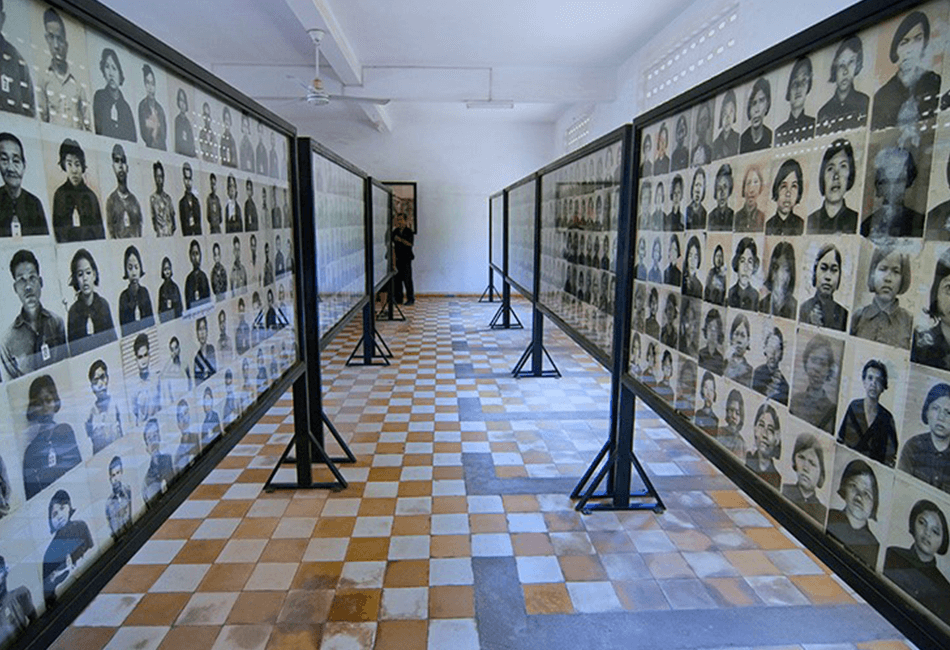When visiting Cambodia, a country with a rich cultural heritage and beautiful landscapes, it’s also important to take a moment to learn about its dark past. One of the most significant historical sites is the Toul Sleng Genocide Museum and the nearby Cheung Ek Killing Fields, which offer a haunting reminder of the atrocities committed during the Khmer Rouge regime. In this article, we will delve into the experience of visiting these landmarks and unravel the impact they have on visitors. Booking Toul Sleng Genocide Museum and Killing Field Tour if you are interesting in it or a Phnom Penh full day tour.
Toul Sleng Genocide Museum: Unveiling the Tragic S21 Prison
Upon arriving at the Toul Sleng Genocide Museum, visitors are immediately confronted with the brutal reality that unfolded within its walls. Formerly known as Security Prison 21 (S21), this former high school turned prison was a place of unimaginable suffering during the Khmer Rouge regime.
What awaits visitors at Toul Sleng Genocide Museum?
Entering the museum, you will find yourself face-to-face with hundreds of haunting photographs of prisoners who were held captive and systematically tortured. The chilling feeling that fills the air is a stark reminder of the horrors that occurred within these very walls.
Understanding the Khmer Rouge regime
The Khmer Rouge regime, led by Pol Pot, subjected its own population to forced labor, torture, and execution between 1975 and 1979. Toul Sleng Genocide Museum stands as a memorial to the estimated 17,000 people who lost their lives within its walls.
Exploring the prison grounds
Exploring the prison grounds, visitors can walk through the former classrooms turned torture chambers and witness the cramped cells where victims were kept. The exhibits present an in-depth narrative of the atrocities committed, providing insight into the methods of torture, interrogation, and the lives of the prisoners.
Cheung Ek Killing Fields: Where Silence Speaks Volumes
Located just outside Phnom Penh, Cheung Ek serves as a somber reminder of the mass killings conducted by the Khmer Rouge regime. This former orchard transformed into a killing field witnessed the execution of thousands of innocent Cambodians.
What can visitors expect at Cheung Ek Killing Fields?
As you arrive at Cheung Ek, you’ll notice the peace and tranquility of the surroundings, creating a stark contrast to the horrors that took place here. The sprawling fields are scattered with memorial stupas, containing the remains of victims discovered in mass graves.
Walking through the history
Visitors are guided along a marked path, enabling them to retrace the steps of the victims. Audio guides and informative plaques help create a vivid picture of the atrocities that unfolded here. From the Killing Tree, against which babies and young children were brutally murdered, to the mass graves still being unearthed, every step serves as a poignant reminder of the tragedy.
Reflecting on the Experience
Visiting the Toul Sleng Genocide Museum and Cheung Ek Killing Fields is a deeply emotional and thought-provoking experience. It’s essential to approach these sites with respect, empathy, and a willingness to learn from the past.
Remembering the victims
As you navigate through these historical landmarks, it’s crucial to honor the memory of the victims and reflect on the importance of preserving their stories. By keeping their legacy alive, we can ensure that the lessons learned from this dark chapter of history are never forgotten.
Education and awareness
Understanding the atrocities committed during the Khmer Rouge regime helps us grasp the importance of promoting peace and respecting human rights. By educating ourselves and sharing our experiences, we can contribute to preventing similar tragedies from occurring in the future.
Conclusion
A visit to the Toul Sleng Genocide Museum and Cheung Ek Killing Fields is a profound journey into Cambodia’s tragic past. It serves as a powerful reminder of the suffering the country endured and the resilience of its people. By immersing ourselves in this history, we can honor the victims and strive for a better future. So, as you plan your trip to Cambodia, make sure to set aside time to visit these landmarks and pay your respects to those who lost their lives.





